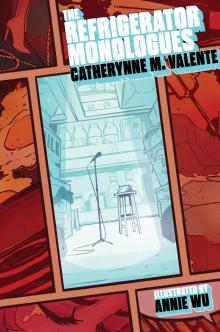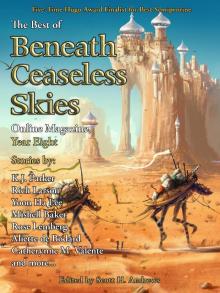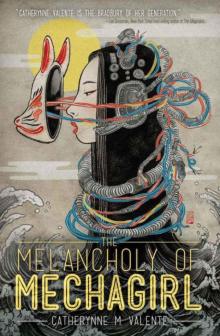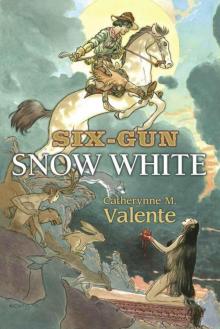


The Atlas of Middle-earth
Karen Wynn Fonstad
All the dates given for the War of the Rings were said to have utilized the Shire Calendar,2 so that was used here as a basis for The Hobbit dates as well. It is possible Tolkien had not yet contrived the Shire Calendar when The Hobbit was written, but even our own calendar would have resulted in just a few days’ variance. Only three dates could be pinpointed in the journey east: April 27—departure from Hobbiton on Thursday “just before May”;3 Midyear’s Day—departure from Rivendell on midsummer morning (intrepreted as synonymous with Midyear’s Day, the summer solstice);4 and September 22—arrival in Lake-town.5 The encounter with the Trolls was when it would “soon be June.”6
Bag End to Rivendell
The number of days spent on the road between Bag End and Rivendell could only be estimated by calculating backward. The company left Bag End on April 27 and Rivendell on Midyear’s Day (where they had spent “fourteen days at least"),7 so they could have been on the road for as much as fifty-one days. The distance from Bag End to Rivendell was slightly more than 400 miles, so the company might have averaged as little as eight miles per day. Perhaps they did not hurry on their way. The weather until late May had been fine and the inns plentiful; whereas camping in the rain and going hungry would have encouraged them to speed up a bit later in the journey. Perhaps they spent more than two weeks in Rivendell—mortals seemed to have great difficulty keeping track of time in the Elvish cities. As a compromise the final estimate was that they travelled for thirty-eight days and spent twenty-seven in Rivendell—still only an average of ten miles per day!
As Frodo and friends later travelled between the same two points, the map west of Rivendell lists for comparison the distances covered in both The Hobbit and The Lord of the Rings. Even on ponies the dwarves appeared to be travelling at snail’s pace, while Frodo was in a continual forced march. Only once did the Dwarves seem more speedy than the Hobbits: in the Trollshaws. The inconsistency arose from the distance between the rushing river and the clearing where Bilbo met the Trolls. The river was not named in The Hobbit, although the revised version of the story specifically mentioned that it had a stone bridge.8 As the Last Bridge crosses the Hoarwell, then the distances disagree. The Trolls’ fire was so close to the river that it could be seen “some way off,”9 and it probably took the Dwarves no more than an hour to reach; whereas Strider led the Hobbits north of the road, where they lost their way and spent almost six days reaching the clearing where they found the Stone-trolls. Lost or not, it seems almost impossible that the time-pressed ranger would have spent six days reaching a point the Dwarves found in an hour. The History series helps explain the discrepancy: the addition of the stone bridge was made as part of an elaborate rewriting done in 1960, which was never published. The proposed revision was that Thorin and Company cross the Last Bridge early in the morning and only reach the campsite near the Trolls in the evening after travelling several miles.10
Unfortunately, even this revision does not significantly improve the situation of Frodo and Company while drastically altering the story line of The Hobbit. Perhaps the most effective solution is that shown by Strachey: interpreting the events to have occurred by a lesser stream (unmapped by Tolkien) closer to the Bruinen, and ignoring both the presence of the bridge and the statement that the river’s source was in the mountains.11 The alternate route shown is based on a sketch map in The History, with the stream added. This is the clearest indication of Tolkien’s true intent, but even it is not ideal, as the distance to the Ford is short given the time and mileage covered after Frodo and friends met Glorfindel.12 Consistently the Dwarves went slower in all their travels than the Hobbits did in the later story. We can only surmise reasons for such variance. It is possible Tolkien had longer distances in mind for The Hobbit travels, and either did not check the effect of the scale placed on the map in the later book or chose to ignore it. Had the scale of the Wilderland map been about twice that of the rest of Middle-earth, the Dwarves’ pace would have been nearer normal. Tolkien “was greatly concerned to harmonise Bilbo’s journey with . . . The Lord of the Rings . . . but he never brought this work to a definitive solution.”13 Rather than analyze too closely, it is preferable we merely gain a general impression of the seemingly endless toil necessary to reach Lonely Mountain.
Rivendell to the Lonely Mountain
Eighty-four days passed between the departure from Rivendell on Midyear’s Day and the arrival in Lake-town on September 22. All of that time was spent en route except the one day of rest at Beorn’s and the days of captivity in the Elvenking’s caverns. The time can be broken into four stages: in the Misty Mountains, the Anduin valley, Mirkwood, and Thranduil’s caverns. The first leg of the journey was spent in climbing the mountains. Rivendell lay west of the range, so the company had to reach and cross the foothills and the lower skirts of the mountains before they even began the long weary ascent to the High Pass. The Dwarves were going so slowly that Bilbo thought, “They will be harvesting and blackberrying, before we even begin to go down the other side at this rate.”14 During their two-day short cut through the Goblin’s tunnels on a Tuesday and Wednesday he found “the blackberries were still only in flower . . . and he ate three wild strawberries.”15 At that latitude, strawberries would probably fruit and blackberries blossom between mid-June and mid-July,16 and later comments about there being an “autumn-like mist” in spite of its being “high summer”17 suggested the latest possible date: mid-July. This would result in a twenty-five day ascent between Rivendell and the Goblins’ Front Porch—certainly longer than the “two marches” Gandalf estimated the Fellowship of the Ring would require to reach the top of the Redhorn Pass.18
After escaping from the Goblins’ back-door the company made a speedy descent to the eastern skirts of the mountains, and with the eagles’ assistance reached Beorn’s the next day. On his ponies they made good time, galloping along Anduin’s grassy valley—a respectable twenty miles per day. Although they left Beorn’s just after noon they covered “many miles” before evening, then continued north for three more days. They travelled especially late on the second day and started at dawn on the last so they could reach the Forest Gate in the early afternoon.
On foot in Mirkwood, progress was slow and “days followed days”—even before Bombur fell into the Enchanted Stream and had to be carried, slowing them more.19 The length of the forest path was 188 miles, of which they had already covered 143 when they reached the stream. Their marches east of there required about a week, so they might have spent up to four weeks crossing the forest, covering little more than six and a half miles each day.
The time spent in captivity in Thranduil’s caverns was “a weary long time.”20 It took Bilbo “a week or two” to find Thorin, and he still had to make and implement his escape plans—- possibly requiring another two weeks.21 When at last he put his plan into action, it was the afternoon of September 21. That afternoon and all the next day were spent barrel-riding to Lake-town in time for arrival on Bilbo’s birthday.
The company made preparations for the last leg of the journey and after only “a fortnight” asked the Master of Lake-town for assistance.22 Assuming at least two days were required to assemble provisions, they would have departed about October 9. They rowed for three days up the Long Lake and the River Running, then rode to the Mountain. They camped for a short time west of Ravenhill, then moved camp to the valley between the western spurs and again to the hidden bay on the mountainside. There they stayed until Durin’s Day allowed them to open the secret door and enter. Calculating backwards, with time allowed for the armies’ march, the siege, the battle, and Bilbo’s return to Beorn’s before Yule,23 Durin’s Day would not have been later than October 30. That was the estimate shown, but if precise calculation of Durin’s Day was beyond the skill of the Dwarves, it certainly was beyond mine.
The Third Age, Year 2941–42
The important dates of The Hobbit appear in the following chronology. It should be remembered that only April 27, Midyear’s Da
y, September 22, 2941, and May 1, 2942,24 were stated or were clearly traceable to Tolkien. All the other dates were calculated and are highly speculative.
APRIL 25. Gandalf visits Bilbo at Bag End.
APRIL 26. Wednesday. The unexpected party.
APRIL 27. Thorin and Company ride out of Hobbiton at 11:00 A.M.
MAY 29. The company crosses a river and are captured by the Trolls.
JUNE 4. They ford the Bruinen and reach Rivendell at dusk.
I LITHE. Midsummer’s Eve. Elrond discovers the moon-letters on Thror’s map.
MIDYEAR’S DAY. The company leaves Rivendell.
JULY 16. Monday. They are captured by the Goblins during the night.
JULY 19. Thursday. Gandalf and the Dwarves escape, Bilbo finds the Ring, meets Gollum, escapes. The company is trapped by wolves and rescued by eagles.
JULY 20. They fly to the Carrock and reach Beorn’s in midafternoon.
JULY 22. They ride out from Beorn’s in early afternoon.
JULY 25. Gandalf departs with ponies at the west edge of Mirkwood.
AUGUST 16. The company crosses the Enchanted Stream. Bombur falls into a trance.
AUGUST 22. They leave the path at night.
AUGUST 23. Before dawn Thorin is captured by the Wood-elves, and the other Dwarves by giant spiders. Bilbo rescues the Dwarves.
AUGUST 24. At dusk the Dwarves are captured by Wood-elves and taken to the Elvenking’s Halls.
SEPTEMBER 21. The company escapes the Elvenking in the afternoon and reaches the huts of the Raft-men at dusk.
SEPTEMBER 22. They reach Lake-town just after sunset.
OCTOBER 9. The company departs from Lake-town by boat.
OCTOBER 12. They leave the river and ride to the Lonely Mountain.
OCTOBER 14. The camp is moved to the western valley.
OCTOBER 19. Bilbo discovers the hidden path. The camp is moved to the hidden bay.
OCTOBER 30. Durin’s Day. The Secret Door is opened at dusk. Bilbo visits Smaug and returns to the Dwarves at midnight.
NOVEMBER 1. Bilbo returns to Smaug’s chamber in the afternoon. In the evening Smaug smashes the door, attacks Lake-town, and is killed.
NOVEMBER 2. Goblins, Beorn, and Gandalf hear of Smaug’s death.
NOVEMBER 3. Elvenking’s host leaves Mirkwood. Thorin learns news.
NOVEMBER 4. Elves turn toward Lake-town.
NOVEMBER 6. Elves reach Lake-town. Dáin receives summons.
NOVEMBER 12. Elves reach Lake-men pass the north end of the Long Lake.
NOVEMBER 15. The joint forces reach Dale at dusk.
NOVEMBER 16. Lonely Mountain is besieged.
NOVEMBER 22. Bilbo gives the Arkenstone to the Elvenking and Bard.
NOVEMBER 23. Dáin arrives in early morning. The Battle of Five Armies. Thorin and Bolg slain.
NOVEMBER 27. Gandalf, Bilbo, and Beorn leave Lonely Mountain.
DECEMBER 30. They arrive at Beorn’s and stay until spring.
MAY 1. Gandalf and Bilbo reach Rivendell.
MAY 8. They leave for Hobbiton, which they reach in June
HOBBIT PATHWAYS Upper: BAG END TO RIVENDELL (VERSUS LOTR) Inset: ALTERNATE PATHS Lower: RIVENDELL TO LONELY MOUNTAIN
Over Hill and Under Hill: Goblin-town
SEEKING SHELTER from a mountain storm, the company found a cave near the top of the High Pass, which turned out to be the newest opening to a vast and intricate network of passages and caves inhabited by Goblins.1 The main entrance had in the past opened on “a different pass, one more easy to travel by . . .,”2 possibly farther south and nearer the East Road. The tunnels have been estimated as thirty-five miles from the Front Porch to the back-door, because the Dwarves spent about two and a half days and had gone “miles and miles, and come right down through the heart of the mountains . . .” to a point west of the Carrock.3
The Capture
The entrance cave itself was “quite a fair size, but not too large . . .”4 In the back wall was a cleverly hidden door: the “black crack.”5 It led to a wide passage that plunged almost steadily down and soon was joined by others that were “crossed and tangled in all directions.” 6 The company was forced to run down the paths as quickly as they could; yet there was sufficient time for the Goblins leading the ponies to have drawn ahead of the Dwarves so far that the saddlebags had already been removed and were being rummaged.7 With no other clues, the distance to the Great Goblin’s cavern has been estimated as five miles. The cavern appears not to have been astoundingly large, so it has been illustrated as about three hundred feet long by one hundred feet high.
After escaping from the cavern the Dwarves’ lead must have been significant. At first they could hear the Goblins’ shouts “growing fainter”; then they ran, and “not for a long while did they stop, and by that time they must have been right down in the very mountain’s heart.”8 When the Goblins caught up, the Dwarves were at a point where the passage had gone around a slight curve, then ran straight for a while before turning a sharp corner. Around that bend Gandalf and Thorin turned to parry, and succeeded in thoroughly surprising and scattering their pursuers. The skirmish bought more time, and the Dwarves “had gone on a long, long way” before they were reattacked.9 In the confusion Bilbo was dropped and left behind.
Bilbo’s Escape
Bilbo probably took the same path as that followed by Gandalf, because he held to the main way and seems merely to have missed turning at the smaller side-passage that led to the outside. Instead, he followed the route to Gollum’s cave, where the passage stopped.10 The distance he covered alone was probably not far, for Bilbo noticed side tunnels almost immediately that, upon his return, seemed only about a mile from the cave.11
Gollum’s cave was natural: Water seeping through the overlying rock had dissolved some of it, washing the residue down to the lake and out into the little stream that Gollum had first followed underground.12 In the center of the lake stood the “slimy island” that was Gollum’s home. The lake was “wide and deep and deadly cold”; yet it has only been shown as four hundred feet in diameter, because from the island Gollum could see Bilbo, could easily carry on a conversation, and could paddle quickly to shore.13
On the return, when Bilbo was fleeing, Gollum counted the side-passages: “’One left, yes. One right, yes. Two right, yes, yes. Two left, yes, yes. . . . Seven right, yes. Six left, yes!’”14 The last was the way to the back-door, and it was not far, because Gollum could smell the Goblins in the guard room. The passage at first went down, then up, then climbed steeply, turned a corner, went down a bit, then finally around another corner—just where it entered the guard room.15 The room centered on the great stone door and must have been relatively small, for the Goblins were “falling over one another” trying to find Bilbo. Once through the outer door Bilbo leaped down the few steps and into the valley.16
GOBLIN-TOWN Cross Section: SOUTHWEST-NORTHEAST
EAGLES’ RESCUE
Out of the Frying Pan
AFTER BILBO LEFT THE GOBLIN TUNNELS he leaped down the stairs to a path in “a narrow valley between tall mountains” from which could be seen glimpses of the plains beyond.1 This upland valley has been shown running into a larger vale going southeast toward Anduin. The orientation was based upon several clues: Southeast was the direction the company would have wanted to travel to regain the main road; it was the way all of the streams mapped by Tolkien flowed from the mountains into Anduin; the Woodmen’s villages in “the southward plains” could be seen from the lower valley and must have been reasonably close to the clearing from which the wolves and Goblins were to have made a raid.2
Once in the larger vale, Bilbo crept along a trail that hugged the north slope, with a wall rising on his left. Below the path in a small dell he found Gandalf and the Dwarves. It was probably about five o’clock on Thursday afternoon, for the sun had already started sinking shortly after Bilbo had escaped the Goblin-gate. The dell was still “pretty high up,” so after a short conversation the com
pany continued along the rough path as quickly as possible, crossed a small stream, and just before night fell (about 8:30 as it was midsummer), they encountered a landslide.3 After skidding to the base of the rock fall, they turned aside into the pine woods that filled the lower valley. Through the trees the Dwarves travelled along “a slanting path leading steadily southwards,” and after “what seemed like ages” they came to a clearing.4
The location of the clearing was not given, but it was apparently still within the foothills, for wolves were heard howling “away down hill.”5 Those evil Wargs soon surrounded the Dwarves and were joined by Goblins, who were about to roast the company when eagles suddenly came to the rescue and carried the Dwarves to their mountain eyrie. The eagles had heard the noise and “flew away from the mountains” to investigate.6 This might seem to indicate the clearing lay east of the eyrie, but instead it has been shown to the south; for the woods lay among the foothills, while the eyrie was atop “a lonely pinnacle of rock at the eastern edge of the mountains,” which according to Tolkien’s illustrations and maps stood amidst the plain at the far end of an east-running ridge.7














